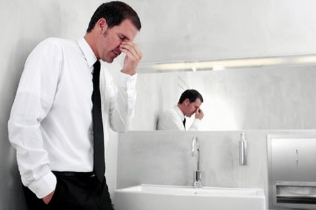As a characteristic of Prostatitis in men: what is it and what are the characteristics, the properties of the primary manifestations of the disease there is? With this knowledge, you can the Problem, not to say over the loud. Prostatitis is the most common urological disease (uretroprostatit), particularly among the older groups of the male population (about 70 %). Today, the symptoms of Prostatitis in men are found often in young people between the ages of 20 to 30 years. Without proper attention and treatment of the disease a very negative influence on male health.

Today, the symptoms of the disease are often detected, and in young people between the ages of 20 to 30 years.
The main causes, which are the basis of the disease, always on the surface. An enlarged prostate can be due to the traditional way of life, the actions of harmful factors, the day-to-day changes in the prostate. The first Phase of the pathology, in General, low, light pain, so that people do not pay attention to the first calls in the future serious problems. The tightening is like a bolt from the blue, if it hurts so that all of the basic life problems are insignificant.Related castaneo coronata symptoms bliznyashki between acute and chronic forms
In the following, some variants of the diseases and their symptoms:
- Stagnant (congestive) Prostatitis is often chronic. The enlargement of the prostate gland for a long time, the beginning of the acute period (exacerbation) can wait for years without knowing what. The reasons why developed congestive Prostatitis:
- A lack of exercise. Stagnation of blood in the small pelvis provokes congestive heart disease and the enlargement of the gland.
- Traumatic Injury To.
- Frequent Constipation.
- Habit of sitting, threw the leg to the leg.
- The Sub-Cooling. If the man is a cold sexual organs, it forms the conditions for the development of an acute inflammation.
- Overheating. Fans of saunas is also pay attention to, prolonged exposure to high temperatures, the area of the small pelvis provokes enlargement of the prostate.
Congestive (congestive) can cause Prostatitis, which is a deterioration of sexual life, so it is important to fix in time all the causes of its formation and take the regular examination at the doctor-the urologist (examination, ultrasound Tests).
- Stones in the prostate — not-so-rare phenomenon, a stone — a frequent companion of men in old age. If in 40 years, the stones of the patients to increases the 50-60 years the percentage of patients on 80 find only at 10%. Concretions are frequent companions of Prostatitis and adenoma (BPH).
- Prostatorrhea — the secretion of fluid from the urethra, which is formed in the prostate gland. The process is without pain, in a row, nature line during a bowel movement or after urination. Prostatorrhea can acute his companion (chronic) Prostatitis or due to the anatomical peculiarities of the arrangement of the; authority.
- Bacterial Prostatitis occurs in contact with the iron in Escherichia coli, resulting in the increase in pain. Bacterial (chronic, acute) inflammatory process is the bacteriological diagnosis must be confirmed by laboratory tests. Often confused with signs of adenoma (BPH — benign Tumor), if it is the number of repeated exacerbations against the background of impaired outflow of urine, and the favorable conditions for the multiplication of pathogenic bacteria.
- BPH — benign Tumor, Oncology, and natural Degeneration of the tissue of the prostate gland due to age-related changes. The increase can be gradual over a number of years, but, according to statistics, men 65-70 years after the almost all of the adenoma of the prostate From the looks of it, you can. on the subject of photos in the Internet Timely examination (ultrasound, blood sampling) will help reduce fluid retention the risk of exacerbation and acute urinary.
- Purulent Prostatitis, his character is one of the most unpleasant for men. There is an increase of the prostate gland due to the accumulation of pus, and of the impossibility of the free outflow from the body. Purulent process is characterized by a high temperature, the man is much pain in the perineum, Palpation is not possible because of the strong discomfort. Early performed ultrasound shows the suppurative process, and the help.
If the man is strong pain in the pelvic area, it must not be delayed, no timely treatment, often the cause of serious complications.
Characteristics of the manifestation of the disease
The first signs of an inflammation of the prostate can feel a man, when you next walk into the toilet. The Problem with the emptying of the bladder, and complaints indicate that the gland, where the inflammatory process has already begun, has to, has enlarged and pinch the urine away. And here's the man commits the first error: is of the opinion that the disease passes by itself. Will not happen, and the beginning of the end of Prostatitis are only "improved" and worse. Learn more about the disease, to begin in time to treat it, you can, by topics, Video or photos on the Internet.
Asymptomatic Prostatitis (asimptomaticheskiy the) — one of the problems, the big problems can deliver in the future. If there is no aggravation, the man is not aware that in the bowels of his body, uretroprostatit, and the first symptoms of the illness Matures start, if the pathological process to the extensive Zone of the prostate.

Often inflammatory process is back pain such as sciatica.
Symptoms of inflammation of the prostate can vary slightly, depending on the shape and severity of the disease. But in men the first signs of Prostatitis are all types of this disease. So clear signals about the presence serve a inflammation of the prostate gland:
- Frequent urge to the toilet.
- Painful or difficult urination.
- Perhaps the rise in temperature to 39 °C (acute course).
A man is experiencing daily discomfort, what prevents its full activity. So, "acquaintance" with Prostatitis, a doctor visit is better not to postpone. Depending on the individual characteristics of the organism, the symptoms vary in each case. Such a variability in the appearance of forms is not always possible in time to recognize the Problem and appropriate treatment to begin. Therefore, it is very important to know how the Prostatitis is manifested, to warn of time to its development.
Often exacerbation of the disease has the following signs (symptoms):
- Pain during urination.
- Violation of sexual functions.
- Discharge from the urethra.
- Burning and pain in the perineum, the scrotum, on the underside of the abdomen.
- The presence in the urine floating threads (mucus) or blood.
- Discomfort during bowel movements.
- Pain in the lower back (like sciatica).
- Chills and weakness, fever (in the case of deterioration).
- Profuse Sweating.
- The feeling of a constantly full bladder.
- Irritability, Nervousness.
- Increased Fatigue.
In the case of chronic course of the Prostatitis is very treacherous. Signs may not manifest itself over the years, and the Patient learns about his disease, only an aggravation.
It is important to note that the first signs of Prostatitis in men, appear, as described above, and all at the same time. The clinical picture of the disease is highly capricious and depends purely on the individual properties of the people, its way of life, preferences, habits. In case of light degree of severity of the inflammatory symptoms, often in waves, which, in turn, of something receding, the introduction of the patients in the mistaken in relation to the General Situation. Recognize the same exact symptoms (stage, species) and to determine the right approach for treatment may be just the urologist with special diagnostic methods (ultrasound), you will learn more about it at the doctor or by the topics Video on the Internet.
- The strength of the pain.
Pain is not usually have the clearly localized character. Pain irradiiruet in the area of the sacrum, the scrotum and perineum, which is confusing a man and forcing the assumption that every disease, except the problems with the prostate gland. The thing is that the iron is not "radiating pain", but the ends of the nerves, when it comes to an increase of the radiation in the shape of the various organs and ailments. The strength of pain depends on the disease, how strong the man is a cold sexual organs. It can go from a pain to a pronounced, not to sleep with the man.

The strength of pain does not depend on the neglect of the disease: from mild to hot, to sleep the man.
- Problems with urination.
Pretty informative Symptom manifests itself in frequent urge to the toilet "small", but after emptying, the feeling remains that the bubble destroyed enough on the ground. This creates an additional psychological burden, especially during the working day. These symptoms are not explained in part by the clamping inflamed prostate, urethral canal, causing the urine soaked free electricity and with delays. In the case of the late treatment of these signs of disease, and subsequently develop urinary retention can progresses.
- Low sexual activity.
It is assumed that Prostatitis leads to complete impotence in the sexual sphere. This is partly true, but in the initial phase of the inflammatory gipotenzia, reflected in the reduction of sexual potency occurs only partially. The causes of the dysfunction can be different, but Prostatitis takes one of the first niches in the process of the formation of sexual problems. Every man in this process is different, but almost always during orgasm and ejaculation, you can feel the pain, which is why a man begins unconsciously to avoid sexual intimacy. If the process of the disease asimptomaticheskiy carries the natural, then the man can not long, the understanding of the causes of sexual problems. What to do in this case? The full inspection and revealing of the disease in the early periods in the future help to avoid problems of pain or acute symptoms of the pathology.
Differences between acute and chronic forms of the
There are two forms of Prostatitis: acute and chronic. Each of them has assigned to its own characteristics, symptoms (but on the photo is almost no strong differences), according to which the diagnosis and treatment.
The first symptoms of the acute course of the disease:
- Discomfort in the groin area.
- Frequent and painful urination (itching, burning).
- The decline of erection.
- In urine pathological inclusions in the Form of threads.
- The sharp increase of the temperature (38-39 °C).
The chronic course of the man brings a lot of trouble: pain, painful urination, sexual dysfunction.
In addition to these characteristics, Prostatitis in men, weakness, nervousness, fatigue and apathy were observed.
Chronic course intensifies all the symptoms during exacerbation of the disease, brings the man a lot of trouble: the physical and psychological. The most important characteristics of the stagnant course of the disease are:
- Pain at the end of (exhausting) pain radiating to the perineum, the testicles, the rectum. In the case of the erection all these characteristics are intensified, so that the intimate proximity brings less fun.
- Frequent urination, painful.
- Sexual Dysfunction.
- If chronic bacterial Prostatitis is the characteristic discharge, viscose Will appear with a yellow. There are also the water and during bowel movements.
Complications of Prostatitis are common and are very heavy. In the case of abscesse of the prostate and Sepsis, the treatment is long and not always successful ends, but such dangerous complications develop, fortunately, very rare.
If you completely ignore signs of disease, or to treat yourself, started chronic process goes to the surrounding organs, what is the inflammatory process. It is the development of additional complications poses lead to infertility. Respond to the first signs of the beginning of a Prostatitis should immediately undergo a comprehensive examination, ultrasound and the analyses. This makes it possible not to develop the disease and the treatment as early as possible.

































